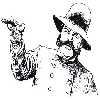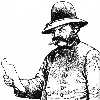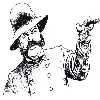Conventional Wargames
The rough outline of my wargaming life was recently revealed to the world in an interview with Robert Nott which appeared in 'Military Illustrated' No.114, November 1997. Essentially I began with 54mm tin cowboys in the early 1960s, then graduated to 20mm Airfix guardsmen which I converted into Napoleonics, and manoeuvred according to a system based on 'mutual agreement' rather than competition or formal rules. The general idea was that the players would take tactical decisions but then debate together to decide what was likely to have happened, rather than playing it through competitively by a set of rules (I would later try to systematise the mutual agreement concept as a 'muggergame', and it was then systematised still further by Chris Engle as a 'matrix game').
The deep influence of Donald Featherstone - and my somewhat belated discovery of the strange idea of formal rules - followed soon afterwards, although I found I had to stretch his principles quite a long way in order to accommodate the historical Napoleonic tactics that I was by then studying at university. I started to experiment with things like variable bounds (later developed by George Jeffrey) and multi-Division armies in 5mm scale. My search for 'alternatives' had begun, although I never had any doubt that wargames could help us to understand real history - and vice versa.
When you play a wargame you are forced to ask certain questions that would not otherwise be asked by historians who are remote from the battlefield in both time and space. This questioning helps you to understand the inner technicalities that may not be mentioned by eyewitnesses, and so it casts a new light on why particular decisions were made or why particular tactics were adopted. The same holds true for re-enactment (I fully sympathise with the 'serious' end of that activity, even though I have never personally taken part). Many myths may be exploded by this questioning process, which would otherwise have been parrotted unthinkingly by people who did not ask the right questions.
In the 1970s I gained experience at Sandhurst in running a hobby wargame club, and I especially came to value any system which had the flexibility to change the level of action rapidly (from Brigade to Division to Corps &c) without necessarily being tied down to the same format merely by the figures that happened to be at hand. Obviously map games without any figures at all were the most flexible: but much could also be done by using the same figures but with different sets of rules for each level of command (command & control in a Brigade is very different from that in a Corps, &c, and the rules have to make allowance. It is not good enough to pretend it doesn't matter!).

|
My final formulation of this line of thinking was published in:
'Napoleonic Wargaming for Fun' (Ward Lock, London 1980: ISBN 0 7063 5813 9), which gives the miniatures gamer a choice of four games using different scales of model. There were games representing multiple Divisions (in 5mm), a single Division (in 15mm), a single Brigade (in 25mm) and a platoon or company (in 54mm). The remaining three games in the book were a boardgame on how a general might divide the time in his day; a 'free kriegsspiel' map game, and an outdoors version which was a wargame adaptation of the traditional military training exercise called a 'TEWT' (or Tactical Exercise Without Troops).
"A real break-through in wargaming literature - no real wargamer can afford to be without it."
Airfix Magazine
"Griffith da un nuovo approccio ai wargame napoleonico."
Modelli Militari
(There was even an edition of the book in Italian, although alas I was never informed of this at the time, and the book is currently out of print in any language).
|
|
While I was running the weekly wargame club at Sandhurst I was asked to put together 'A Book of Sandhurst Wargames' (Hutchinson, London: ISBN 0 09150451 1, and Coward McCann & Geoghegan, New York 1982: ISBN 0 698 11198 2). This is a celebration of the club, with four specially-designed and profusely-illustrated boardgames. They feature, respectively, the Black Prince's campaigns (or 'war rides') in Aquitaine (1355 & 1356); the battle of Craonne (1814); British attempts to sink the Tirpitz in WW2, and the small unit combat on Pacific atolls that was observed by SLA Marshall. The whole book and its game maps were most lavishly and effectively illustrated by Bernard Higton and his team, which sparked my long term interest in creating illustrated books.
'Aquitaine' enjoyed a certain success in the Society of Ancients (except with Charles Vasey), while there was at one time a scheme to play 'Men Against Fire' in 1:1 scale as a serious piece of operational research (Marshall had made the surprising claim that in some firefights only one man in twenty fired his weapon - let alone took careful aim - which clearly upset any predictions of fire efficiency that were based on an assumption that even a quarter of soldiers would shoot). But alas the book is now out of print, as was predicted in Bill Haggart's review (although it did not help that the publisher had remaindered it before it had even appeared...)
|

|




